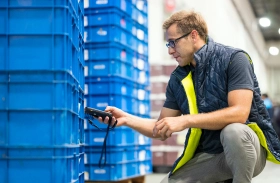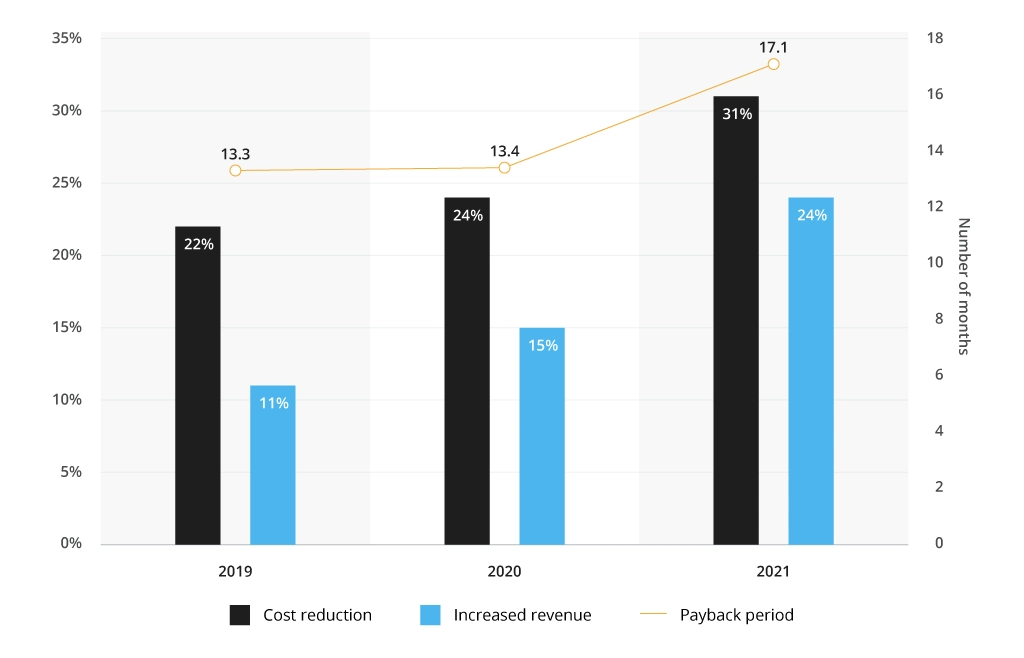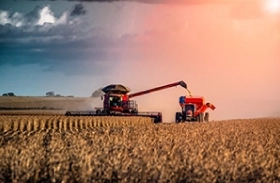The Potential of RPA Bots in Agriculture: Possibilities and Limitations
The worldwide digital farming market is projected to reach $15 billion by 2027. As for intelligent automation, 74% of organizations are already leveraging RPA for enhanced productivity and cost reduction. With that in mind, adopting robots for daily farming operations, including back-office tasks, looks more than reasonable.
Key Benefits of RPA in Agriculture
RPA bots are hitting the mainstream for a reason. By automating a variety of field processes, they answer a number of challenges, bringing tangible value.
Enhanced Efficiency
Companies significantly benefit from RPA in terms of efficiency. Namely, such intelligent bots can help reduce intensive labor tasks by 80%, ensure 99% accuracy, and enable 80%-90% in time savings.
By automating certain repetitive management processes around seed planting, crop monitoring, irrigation, livestock management, and more, farmers can become more productive, which in turn results in both substantial time and money saved.
A case in point: Infopulse helped a large international food and agro-technical company implement a scalable RPA solution to automate an array of business processes. As a result, the client enhanced productivity on an organization-wide scale, lowered the time of task execution, and freed up data accounting specialists from routine work.
Improved Yield
Yield is generally affected by factors grouped into three categories: technological, biological, and environmental. Each of them can be effectively managed to achieve better outcomes. Automated routine tasks that are free of human error, predictive analytics to prevent plant diseases, real-time monitoring to control climatic conditions — RPA bots can enable that and more. Smart automation also means better accuracy, resource optimization, minimized wastage, and environmental footprint reduction.
Slashed Cost
Another significant benefit you can gain by implementing RPA is reducing costs. According to Deloitte, companies that have adopted intelligent automation see an average cost reduction of 32%, up from 24% in 2020.
At first, implementing RPA might seem like an expensive idea, but its value will give you more bang for your buck. You will avoid spending more resources than needed, prevent crop failure due to human error, and quickly and efficiently respond to unexpected or extreme climatic conditions.
Automation in Agriculture: Five Use Cases
RPA is already reinventing the industry, and with robotics innovation showing no signs of abating, the impact of automation in agriculture will only grow. Autonomous tractors, robotic harvesters, automatic watering robots — all these smart machines will still need RPA in place to ensure the automatic execution of some back-office operations.
Back-office operations that RPA can help you automate in agriculture:
- Data entry, data aggregation, and reporting
- Invoice processing
- Data entry to CRM and ERP systems (e.g., sales order entry)
- Accounting and purchase orders reconciliation
- Data gathering, querying, provisioning across databases, applications, and portals
- Automating data entry for payroll transactions
Soil Preparation
Rich yields greatly depend on soil preparation. Different soils need different approaches, and intensive farming might lead to soil degradation. Here is where advanced technologies and automation in agriculture come into play to solve this challenge.
IoT sensors embedded in the soil collect detailed data like current nutrition levels, color, texture, depth, structure, porosity, and stone content — and send it to the cloud. RPA bots then retrieve this data, structure it according to the predetermined parameters, and transport it into a particular template or a spreadsheet to form a report for farmers. Underpinned by such detailed reports sent at specific intervals, workers can tailor to the specific needs of each soil patch, making preparations in a more meaningful, data-driven way. This includes:
- Plowing
- Pesticide spraying
- Manuring
- Pest and weed control
- Precise irrigation
Field Irrigation
As the Organization for Economic Cooperation and Development (OECD) reports, agriculture accounts for 70% of water use globally, and extreme groundwater pumping to fulfill irrigation needs results in negative environmental externalities. To mitigate these consequences and conserve a sustainable agro-food sector, there is an urgent necessity to improve agricultural water management. This can be done through automation.
Powered by machine learning algorithms, smart RPA bots gather sensor-based information on soil moisture levels, weather conditions, and other important factors to help a human or AI determine the exact amount of water needed for each particular crop. If the process of irrigation is fully automated, then plants can receive the right amount of water at the right time. This allows agronomists to maximize resource efficiency, curb water usage, and avoid costly bills.
Crop Monitoring and Supply Chain Management
Drone technology popularity isn’t going to fade anytime soon, and RPA goes hand in hand with it. With an estimated $38 billion market share in 2023, drone investment is expected to reach $62.4 billion by 2028, growing at a CAGR of 10.42%. In agriculture alone, drones are valued at $1.4-8.8 billion in the 2021-2028 period. And there are clear reasons for that.
Empowered with sensors, cameras, and GPS tech, crop monitoring drones fly over large areas and collect essential data on crop health, moisture, and other key metrics, sparing human workers the need to walk through pastures taking soil samples. The role of RPA in this case is to automate high-volume data processing and analytics processes that can become not only less time-consuming, but even more precise.
Drones, as well as RPA, can also be used to optimize the supply chain — drones to automate the order delivery, while RPA to process those orders, manage inventory and shipping, etc.
Seed Planting and Crop Harvesting
Every particular crop has its specifics of how it should be harvested: what time of the year, best month(s) or weeks, as well as at which size, color, and maturity. On an industrial scale, manual control of all these parameters is labor-intensive and demanding. Here is where RPA bots come into play.
They can collaborate with IoT sensors that monitor an array of variables in real time — to collect, verify, cleanse, sort, and manage the received data, and then send it for comprehensive analysis by AI. Smart OCR and NLP mechanisms then cross-reference this data against the existing knowledge base, specify the harvest time, and automatically schedule the harvesting process. Such an automated workflow helps prevent late harvests, food from perishing, and crop transportation delays.
Yield Prediction
Data analytics constitutes a rapidly growing market. In 2022, it was valued at US $294.16 billion, and by 2028, this number is projected to reach a stunning $662.63 billion. Such figures are not surprising considering the benefits this technology brings to every industry.
Agriculture is no exception. RPA bots can extract data from monitoring systems, IoT sensors, databases, and websites (through APIs), and analyze it. Supported with advanced analytics and machine learning capabilities, RPA takes part in the delivery of accurate yield predictions. Hence, the main job of RPA in this case is to provide maximum variables to ML based on different parameters used for analysis, including temperature, humidity, wind speed, soil conditions, seed and fertilizer type, crop weight, and others. The more variables the ML models use, the better prediction results farmers receive. More precise results mean optimized resource management practices and reduced labor costs.
Limitations of Using RPA in Agriculture
As with any innovative technology, RPA bots have their limitations and challenges; however, these can be addressed with expert help.
Other Technologies Should Be Integrated
RPA bots can automate an array of repetitive and time-consuming tasks in digital farming, but to achieve full automation, you will also need to take in AI/ML, IoT, computer vision, NLP, OCR, and predictive and advanced analytics. The smart fusion of such technologies leads to the needed level of hyperautomation that focuses on optimizing business processes across an enterprise. For example, if you need to predict yields or control crops, you should build a data model that heavily relies on machine learning while also using RPA to automate such routine tasks as data collection and preparation. To achieve the most precise prediction outcomes, the model should be continuously refined, which is again the matter of advanced analytics.
A case in point: Infopulse, relying on its knowhow in IoT, AI/ML, big data analytics and industry expertise, built an Azure-based data platform that provides both automation and advanced analytics capabilities to track all agricultural operations almost in real-time.
The Need for Comprehensive Tech Skills
As PwC suggests, 39% of employees are worried about insufficient technology training from their employer. This percentage is quite high, meaning companies do not always take into consideration the fact that inadequate skills represent a significant hurdle in their digital adoption efforts.
As for agriculture, farmers should not only be in the loop of next-gen machines capable of substituting for humans, but also master all the automation capabilities RPA offers together with other complementing technologies like AI, ML, OCR, IoT, and data analytics. This is where RPA technology adoption programs like this one from Infopulse can become beneficial.
Domain Knowledge
There are many companies that specialize in end-to-end back-office automation, but not all of them possess deep knowledge of the agricultural domain, i.e., do not know exactly how to use RPA bots in connection with agricultural robotics and the relevant hardware specifics that come with it. To do things right from the start, team up with a vendor that has substantial experience in your industry and can address the most complex business challenges.
Conclusion
No matter what robotics hardware you will use in the field for automatic irrigation, crop monitoring, and yield prediction, RPA bots can help you make the whole process more automated, error-free, and smarter. Depending on your particular industrial needs, an adept vendor like Infopulse will help you implement a tailored RPA application, perfectly suited to your IT landscape, with the focus on business continuity and TCO optimization.
![RPA Bots in Agriculture [banner]](https://www.infopulse.com/uploads/media/banner-1920x528-the-potential-of-RPA-bots-in-agr.webp)





![Robotic Invoice Process Automation [thumbnail]](/uploads/media/automating-invoicing-with-rpa-280x222.webp)
![RPA Licensing Cost Optimization Guide [thumbnail]](/uploads/media/thumbnail-280x222-a-guide-to-optimizing-licensing-costs-when-adopting-rpa.webp)
![Technology for Agriculture [thumbnail]](/uploads/media/thumbnail-280x222.webp)
![RPA vs Intelligent Automation vs Hyperautomation [thumbnail]](/uploads/media/how-to-move-from-rpa-to-intelligent-automation-or-hyperautomation-280x222.webp)



![Cross-Industry RPA Benefits [thumbnail]](/uploads/media/cross-industry-benefits-of-robotic-process-automation-rpa-280x222_v2.webp)